Pituophis melanoleucus
Pituophis melanoleucus, commonly known as the pine snake, is a species of nonvenomous snake in the family Colubridae. The species is endemic to the southeastern United States. Three subspecies are currently recognized as being valid.
| Pituophis melanoleucus | |
|---|---|
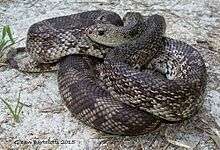 | |
| Suwanee County, FL - pine snake | |
| Scientific classification | |
| Kingdom: | Animalia |
| Phylum: | Chordata |
| Class: | Reptilia |
| Order: | Squamata |
| Suborder: | Serpentes |
| Family: | Colubridae |
| Genus: | Pituophis |
| Species: | P. melanoleucus |
| Binomial name | |
| Pituophis melanoleucus (Daudin, 1803) | |
| Synonyms | |
| |
Taxonomy and etymology
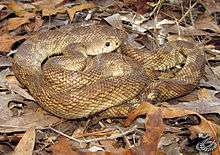
Three subspecies of Pituophis melanoleucus are currently recognized: the nominate subspecies P. m. melanoleucus (Daudin, 1803), the northern pine snake; P. m. lodingi (Blanchard, 1924), the black pine snake; and P. m. mugitus (Barbour, 1921), the Florida pine snake.[4]
The subspecific name lodingi is in honor of Danish-born amateur herpetologist Peder Henry Löding (1869-1942), who lived in Alabama.[5]
The species has a variety of common names, including: pine snake, pinesnake,[4] common pine snake, bullsnake, black and white snake, carpet snake, chicken snake, common bullsnake, eastern bullsnake, eastern pine snake, horn(ed) snake, New Jersey pine snake, North American pine snake, northern pine snake, pilot snake, and white gopher snake.[6]
Description
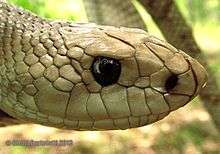
Adults of P. melanoleucus are large, growing to 48–90 in (120–230 cm) in total length (including tail)[7] and are powerfully built. The head is small and somewhat pointed with an enlarged rostral scale that extends upward between the internasal scales. Usually, four prefrontal scales are seen. At midbody are 27-37 rows of keeled dorsal scales.[8] The anal plate is single.[9] The color pattern consists of a light ground color overlaid with black, brown, or reddish-brown blotches.[8]
Geographic range and habitat
The species P. melanoleucus is found in the United States in Alabama, Florida, Georgia, Kentucky, Louisiana, Mississippi, New Jersey, North Carolina, South Carolina, Tennessee, Delaware and Virginia.[6][9] The nominate subspecies occurs in southern New Jersey, southern North Carolina west through South Carolina to northern Georgia, eastern Tennessee, southeastern Kentucky and south into Alabama. P. m. lodingi occurs from southwestern Alabama to eastern Louisiana, overlapping with P. m. mugitus from southern South Carolina to Georgia and southern Florida.[2] A population of the subspecies, originating from released or escaped pets, has established itself in the Netherlands in the coastal dunes and dune forests around Wassenaar.[10]
The pine snake inhabits pine flatwoods, sandy pine-oak woodlands, prairies, cultivated field, open brushland, rocky desert and chaparral. It occurs from sea level to an elevation of 9,000 ft (2,700 m).[8] The pine snake requires well-drained, sandy soils with little vegetation for use as nesting and hibernation sites.[1]
Ecology
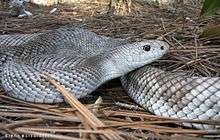
The pine snake preys on rats, mice, moles and other small mammals and eggs.[6] It often enters rodent burrows in search of a meal. In these cases, multiple kills are frequent, with the snake pressing the mice against the walls of the burrow.[11] The snake remains underground in cold weather or during the heat of summer days.[1]
When disturbed, it often hisses loudly, sometimes flattening its head, vibrating its tail, and eventually striking at an intruder.[8] To make the rattling sound, the snake forces air out of its lungs, vibrating the epiglottis.[12]
Reproduction
After mating has taken place in spring, clutches of three to 24 eggs are laid in June–August. The eggs are deposited in sandy burrows or under large rocks or logs and hatch after 64–79 days of incubation.[8] The eggs are adherent and quite large, up to 66 mm (2.6 in) long by 45 mm (1.8 in) wide. Hatchlings measure 33–45 cm (13–18 in).[6]
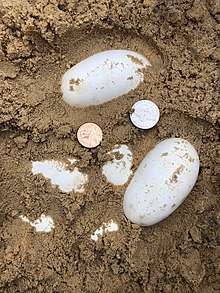
Conservation status

The pine snake is classified as least concern on the IUCN Red List, due to its wide distribution and large number of subpopulations; while the total populations appears to be declining, this is likely happening at a slow rate. However, the species is thought to be impacted by continued habitat degradation and destruction. It is present in a variety of protected areas.[1]
References
- Hammerson GA (2007). "Pituophis melanoleucus ". IUCN Red List of Threatened Species. 2007: e.T63873A12723588. doi:10.2305/IUCN.UK.2007.RLTS.T63873A12723588.en.
- Pituophis melanoleucus at the Reptarium.cz Reptile Database. Accessed 29 June 2008.
- Stejneger L, Barbour T (1917). A Check List of North American Amphibians and Reptiles. Cambridge Massachusetts: Harvard University Press. 125 pp. (Pituophis melanoleucus, p. 86).
- "Pituophis melanoleucus". Integrated Taxonomic Information System. Retrieved 29 June 2008.
- Beolens, Bo; Watkins, Michael; Grayson, Michael (2011). The Eponym Dictionary of Reptiles. Baltimore: Johns Hopkins University Press. p. 160. ISBN 978-1-4214-0135-5.
- Wright AH, Wright AA (1957). Handbook of Snakes of the United States and Canada (7th printing, 1985 ed.). Ithaca and London: Comstock Publishing Associates, a Division of Cornell University Press. pp. 589, 609–621. ISBN 978-0-8014-0463-4.
- Powell, Conant, Collins (2016).
- Behler JL, King FW (1979). The Audubon Society Field Guide to North American Reptiles and Amphibians. New York: Alfred A. Knopf. pp. 644–645. ISBN 978-0-394-50824-5.
- Conant R (1975). A Field Guide to Reptiles and Amphibians of Eastern and Central North America (Second ed.). Boston: Houghton Mifflin Company. pp. 199–200. ISBN 978-0-395-19979-4.
- "Vondst Amerikaanse wurgslang is geen toeval: 'Er zitten er veel meer' ". Omroep West (in Dutch). Retrieved 2017-06-19.
- Mehrtens JM (1987). Living Snakes of the World in Color. New York: Sterling Publishers. ISBN 978-0-8069-6460-7.
- "The Northern Pinesnake". Virginia Department of Game and Inland Fisheries.
Further reading
- Barbour T (1921). "The Florida Pine Snake". Proc. New England Zoöl. Club 7: 117-118. (Pituophis melanoleucus mugitus, new subspecies).
- Blanchard FN (1924). "A Name for the Black Pituophis of Alabama". Pap. Michigan Acad. Sci., Arts, Letters 4: 531-532. (Pituophis lodingi, new species).
- Conant R, Bridges W (1939). What Snake Is That? A Field Guide to the Snakes of the United States East of the Rocky Mountains. (With 108 drawings by Edmond Malnate). New York and London: D. Appleton-Century Company. Frontispiece map + 163 pp. + Plates A-C, 1-32. (Pituophis melanoleucus, pp. 66-68 + Plate 10, figure 29; Plate 11, figure 30).
- Daudin FM (1803). Histoire Naturelle, Générale et Particulière des Reptiles ..., Tome Sixième [Volume 6]. Paris: F. Dufart. 447 pp. + Plates I-X. (Coluber melanoleucus, new species, p. 409). (in French).
- Goin CJ, Goin OB, Zug GR (1978). Introduction to Herpetology, Third Edition. San Francisco: W.H. Freeman. xi + 378 pp. ISBN 0-7167-0020-4. (Pituophis melanoleucus, pp. 122, 141).
- Holbrook JE (1842). North American Herpetology; or, A Description of the Reptiles Inhabiting the United States. Vol. IV. Philadelphia: J. Dobson. 138 pp. + Plates I-XXXV. (Pituophis melanoleucus, pp. 7-10 + Plate I).
- Morris, Percy A. (1948). Boy's Book of Snakes. (A volume of the Humanizing Science Series, edited by Jaques Cattell). New York: Ronald Press. viii + 185 pp. (Pituophis melanoleucus, pp. 44-47, 180).
- Powell R, Conant R, Collins JT (2016). Peterson Field Guide to Reptiles and Amphibians of Eastern and Central North America, Fourth Edition. Boston and New York: Houghton Mifflin Harcourt. xiv + 494 pp., 47 plates, 207 figures. ISBN 978-0-544-12997-9. (Pituophis melanoleucus, pp. 391-392 + Plate 37).
- Schmidt KP, Davis DD (1941). Field Book of Snakes of the United States and Canada. New York: G.P. Putnam's Sons. 365 pp., 34 plates, 103 figures. (Pituophis melanoleucus, pp. 160-162, Figure 46).
External links
| Wikimedia Commons has media related to Pituophis melanoleucus. |
- The Florida Pinesnake: Pituophis melanoleucus mugitus - University of Florida Fact Sheet 2009
- "Black Snakes": Identification and Ecology - University of Florida fact sheet
- Northern Pine Snake at The Pituophis Page. Accessed 29 June 2008.
- New Jersey Pine Snake at The State of New Jersey. Accessed 29 June 2008.
- Florida Pine Snake
